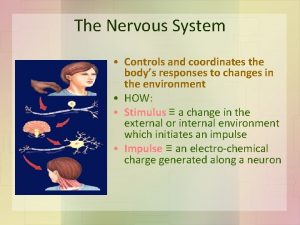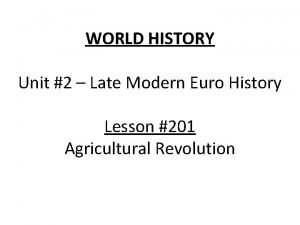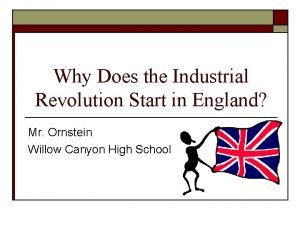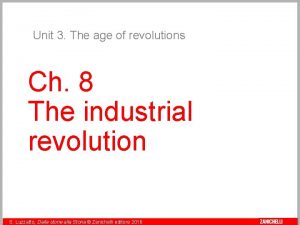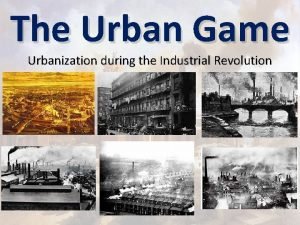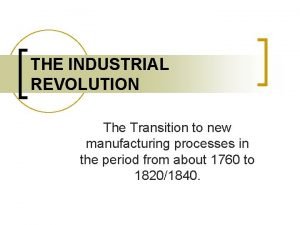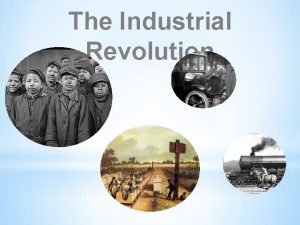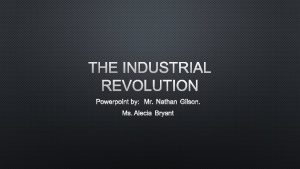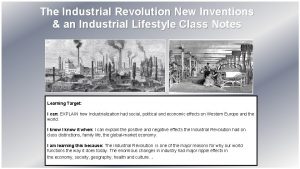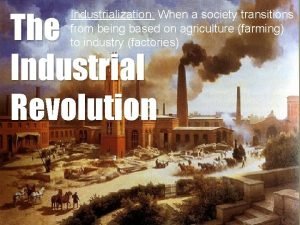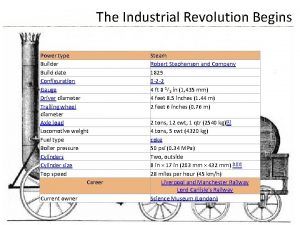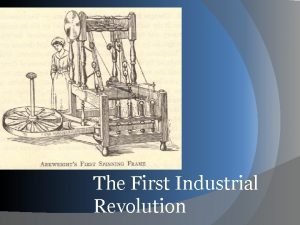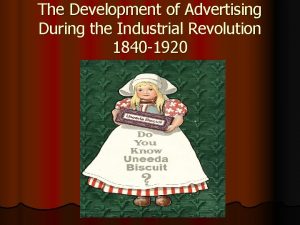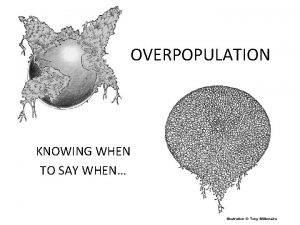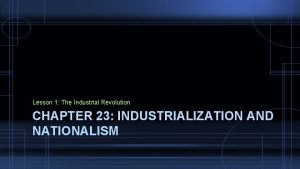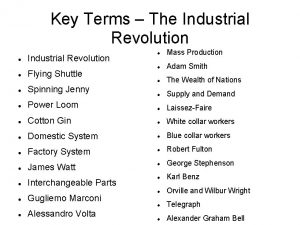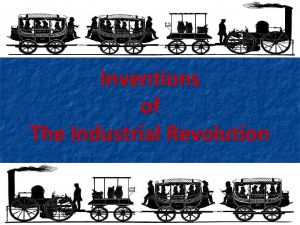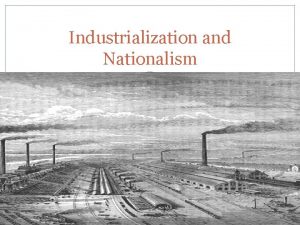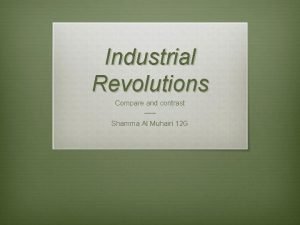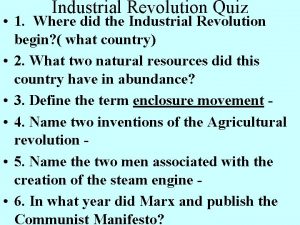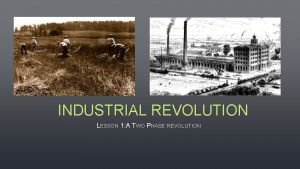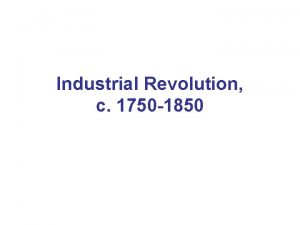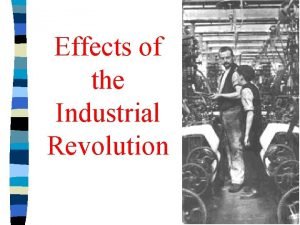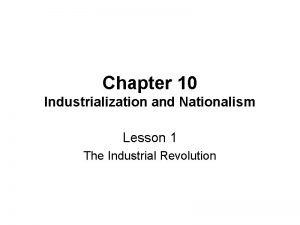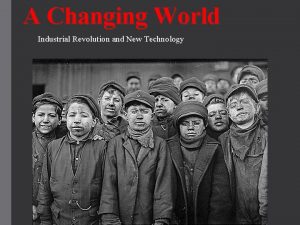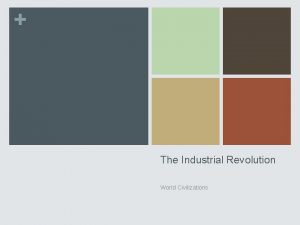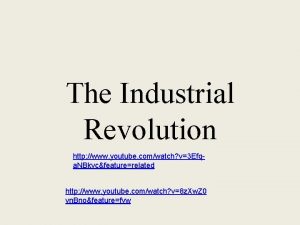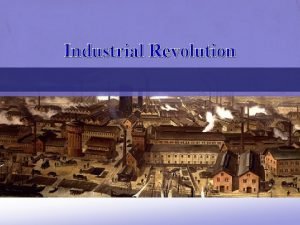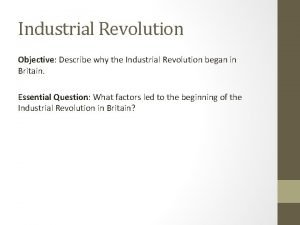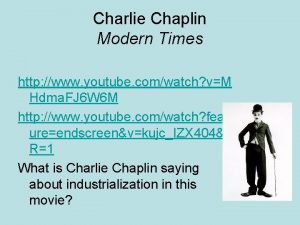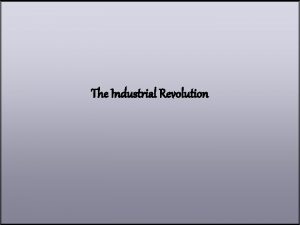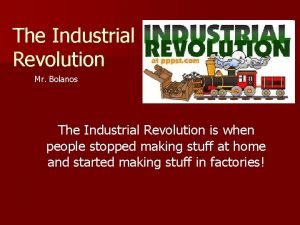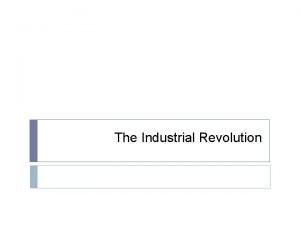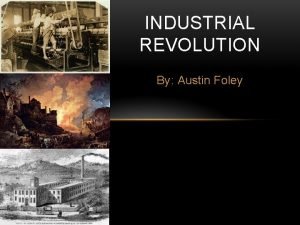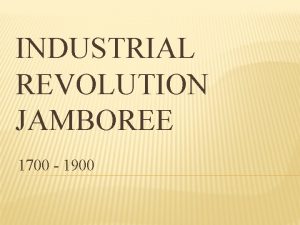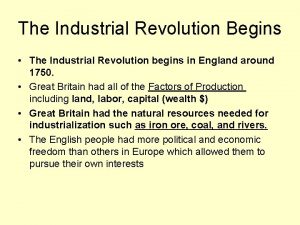Unit 5 Industrial Revolution Societys Response THE CHANGES



















































- Slides: 51

Unit 5 Industrial Revolution & Society’s Response

THE CHANGES THAT SWEPT GREAT BRITAIN IN THE 18 TH CENTURY AND EUROPE AND NORTH AMERICAN DURING THE 19 TH CENTURIES TRANSFORMED THE WESTERN WORLD FROM A RURAL SOCIETY TO AN URBAN ONE.


NEW FARMING METHODS … CREATED A FOOD REVOLUTION OFTEN CALLED the ND 2 AGRICULTURAL REVOLUTION

The 2 nd Agricultural Revolution was a: A. revolt by farmers protesting low prices of farm products in the early 1800 s B. period of rapid technology innovation leading to improved crop yields and crop surpluses C. period of history in which small farms were combined into larger ones and run by the government, creating improved crop yields and crop surpluses D. rapid increase in numbers of farmers and farm production caused by loss of manufacturing jobs and shift of workers from urban industry to rural agriculture.

The 2 nd Agricultural Revolution was a: A. revolt by farmers protesting low prices of farm products in the early 1800 s B. period of rapid technology innovation leading to improved crop yields and crop surpluses C. period of history in which small farms were combined into larger ones and run by the government which created improved crop yields and crop surpluses D. rapid increase in numbers of farmers and farm production caused by loss of manufacturing jobs and shift of workers from urban industry to rural agriculture.

Agricultural Innovation STEAM TRACTOR – replacement of horse drawn plow allowed 1 man to do the work of 3. Food production increased despite the decrease in agricultural labor force.

Agricultural Innovation ENCLOSURE SYSTEM – public communal land in Great Britain was purchased by wealthy landowners. Small plots were enclosed, then rented back to tenant farmers for planting. Landlords were given the freedom to experiment with new ways of farming and increasing production without interference of neighboring farmers. More laborers for industrial workforce. Many farmers were forced off of their farms and had to move to cities to look for work.

Agricultural Innovation CROP ROTATION – since ancient times, fields were left unplanted for a season to allow the soil to recover. Viscount Charles Townsend discovered that planting every year was possible if one rotated the types of crops planted in the same field each year.

Agricultural Innovation FERTILIZER – scientists discovered that synthetic fertilizers were more effective in increasing crop yields than natural treatments (manure).

Agricultural Innovation REAPER – a horse drawn device invented by American Cyrus Mc. Cormick that could harvest the crop much more efficiently than workers using scythes. With the reaper fewer workers were needed to harvest the crop.

Cyrus Mc. Cormick and the reaper Cyrus Mc. Cormick invented a mechanical reaper, cut grain from the fields. This allowed farmers to plant much more seed because they could harvest it easier.

Mechanical Reaper Inventor: Cyrus Mc. Cormick Year: 1831 Cut wheat many times faster than a human worker could Enabled farmers to cultivate more land with fewer workers Great for the prairies of the Midwest

Cyrus Mc. Cormick & the Mechanical Reaper: 1831

Agricultural Innovation SEED DRILL this device was “re-invented” during the Agricultural Revolution. Rather than scattering seeds by hand, it planted seeds under the soil at regular intervals. Crop yield per acre was dramatically increased. 10: 35 – 15: 16 European Seed Drill ca. 1828

John Deere and the plow In 1836, John Deere invented a lightweight plow with a steel cutting edge. Deere’s plow made preparing the ground for planting much less work.

Metal Plow Inventor: John Deere Year: 1837 Blacksmith Tough plains soil could not be plowed by cast iron plows (sticking) Assisted farmers greatly

John Deere & the Steel Plow (1837)

The Threshing Machine The threshing machine separated the kernels of wheat from the husks, which was a far faster way of getting wheat than picking it by hand. The threshing machine increased the growing of wheat.

NEW FARMING METHODS … created a FOOD REVOLUTION OFTEN CALLED the 2 ND AGRICULTURAL REVOLUTION

Video Clip http: //www. history. com/videos/the-industrialrevolition#the-industrial-revolition

Industrial Revolution The first Industrial Revolution began in England in the late 18 th century. An industrial revolution is when hand tools are replaced by factory machines, and farming is replaced by large-scale manufacturing. An example is the making of clothes.

Spinning Jenny and Power Loom Before the Industrial Revolution, clothes were made at home. Afterwards, clothes were made by machines in factories. Often these machines were run by children.

Steamboat Robert Fulton designed a steam engine for a steamboat that could move against the current of a river or against the wind. The steamboat created more opportunities for trade and transportation on rivers.

Steamboat Builder: Robert Fulton Year: 1807 First practical steamboat was called the Clermont Made traveling on river easier and faster Canals Used for trade and the moving of raw materials First oceangoing steamship wouldn’t be produced until 1850 in Great Britain

Robert Fulton & the Steamboat 1807: The Clermont

Telegraph Inventor: Samuel Morse Year: 1844 Revolutionized communication Morse Code Factories in the East could now communicate with markets in the West

The Telegraph The telegraph was invented by Samuel Morse. This machine sent long and short pulses of electricity along a wire. With the telegraph, it took only seconds to communicate with another city. The invention of the steamboat and telegraph brought the people of the nation closer to each other.

Samuel F. B. Morse 1840 – Telegraph

The cotton gin Inventory Eli Whitney also invented the cotton gin. The gin took the seeds out of the cotton, which was much faster than doing it by hand. The cotton gin also greatly expanded the need for slaves.

Cotton Gin Inventor: Eli Whitney Year: 1794 Need for cotton by factories in the North A worker could produce fifty time more cotton fiber Increase of slave labor “Cotton Kingdom: ” owners of large plantations

Eli Whitney’s Cotton Gin, 1791 Actually invented by a slave!

Sewing Machine Inventor: Elias Howe Year: 1846 Made producing clothing efficient Made cloths less expensive so even the lower and middle classes could dress like the wealthier Americans Ties back to cotton

Elias Howe & Isaac Singer 1840 s Sewing Machine

Vulcanized Rubber Inventor: Charles Goodyear Year: 1839 Made working with rubber easier (sticking when hot and hard when cold) Removed sulfur and then heated so it would retained its elasticity

Invention Billboard Select one invention of the Industrial Revolution and create a billboard that could have appeared along the at this time to advertise your item. It must be in color. Should be attractive and eye-catching. Think about the billboards you see along our roads. Design a slogan to promote your item. It must be time appropriate!

Factory System The factory system had many workers under one roof working at machines. Many people left farms and moved to the city to work in factories. They wanted the money that factories paid. This change was not always for the better.

Samuel Slater (“Father of the Factory System”)

Thread-Spinning Mill Builder: Samuel Slater Year: 1789 Apprentice in one of Arkwright’s Factories (Great Britain) Produced cotton thread Rapid rate of production

Factories Come to New England was a good place to have a factory. Factories needed water power, and New England had many fast-moving rivers.

Power Loom Builder: Francis Lowell Year: 1814 Improved versions of English machines Brought spinning and weaving Allowed textile work to be done a lot faster

Early Textile Mill Loom Floor

The Lowell Mills Hire Women In 1813, Francis Cabot Lowell built a factory in eastern Massachusetts, near the Concord River. The factory spun cotton into yarn and wove the cotton into cloth. Something was different about this factory, they hired women. The “Lowell girls” lived in company-owned boardinghouses. The girls worked over 12 hours a day in deafening noise.

The Lowell Girls Young women came to Lowell in spite of the noise. They came for the good wages: between two and four dollars a week. The girls usually only worked for a few years until they married.

Lowell Mill


I’m a Factory Girl Filled with Wishes I'm a factory girl Everyday filled with fear From breathing in the poison air Wishing for windows! I'm a factory girl Tired from the 13 hours of wok each day And we have such low pay Wishing for shorten work times! I'm a factory girl Never having enough time to eat Nor to rest my feet Wishing for more free time! I'm a factory girl Sick of all this harsh conditions Making me want to sign the petition! So do what I ask for because I am a factory girl And I'm hereby speaking for all the rest!

Interchangeable Parts The first use of interchangeable parts was created by inventor Eli Whitney. Before this time, guns were made one at a time. Each gun was different. If a part broke, a new part had to be created. Whitney created muskets with exactly the same parts, so any part would fit any gun. The use of interchangeable parts speeded up production, made repairs easier, and allowed the use of lower-paid, less skilled workers.

Eli Whitney’s Gun Factory Interchangeable Parts Rifle

New Technologies help nation grow With new farm equipment, Midwestern farmers grew food to feed Northeastern factory workers. Midwestern farmers became a market for Northeastern manufactured goods. The growth of the textile factories increased the demand for Southern cotton. This led to the expansion of slavery.

Video Review Crash Course http: //www. youtube. com/watch? v=zh. L 5 DCizj 5 c&safe=a ctive
 Changes in latitudes, changes in attitudes meaning
Changes in latitudes, changes in attitudes meaning Chemical and physical change
Chemical and physical change Which system coordinates the body's response to changes
Which system coordinates the body's response to changes Russian revolution vs french revolution
Russian revolution vs french revolution How could the french revolution been avoided
How could the french revolution been avoided Third agricultural revolution
Third agricultural revolution Natural and forced response
Natural and forced response Natural response circuit
Natural response circuit A subsequent
A subsequent How changed
How changed Why did the industrial revolution start in britain
Why did the industrial revolution start in britain Industrial revolution zanichelli
Industrial revolution zanichelli The urban game us history
The urban game us history Enclosure movement industrial revolution
Enclosure movement industrial revolution Long term impacts of the industrial revolution
Long term impacts of the industrial revolution Industrial revolution transition
Industrial revolution transition Industrial revolution quiz
Industrial revolution quiz Nathan gilson
Nathan gilson Negative effects of the industrial revolution
Negative effects of the industrial revolution The effects of the industrial revolution meme
The effects of the industrial revolution meme Industrial revolution
Industrial revolution Water frame significance
Water frame significance Advertisements during the industrial revolution
Advertisements during the industrial revolution Enclosure movement
Enclosure movement 2nd industrial revolution timeline
2nd industrial revolution timeline Thomas malthus industrial revolution
Thomas malthus industrial revolution Chapter 23 lesson 1 the industrial revolution
Chapter 23 lesson 1 the industrial revolution Radio shuttle factories
Radio shuttle factories Phonograph industrial revolution
Phonograph industrial revolution Chapter 10 industrialization and nationalism
Chapter 10 industrialization and nationalism First and second industrial revolutions
First and second industrial revolutions Industrial revolution vocabulary
Industrial revolution vocabulary Entrepreneurs industrial revolution
Entrepreneurs industrial revolution Long term impacts of the industrial revolution
Long term impacts of the industrial revolution Quiz 1 early development of industry
Quiz 1 early development of industry The industrial revolution lesson 1
The industrial revolution lesson 1 Industrial revolution jeopardy
Industrial revolution jeopardy Enclosure movement industrial revolution
Enclosure movement industrial revolution Negative effects of the industrial revolution
Negative effects of the industrial revolution Negative effects of the industrial revolution
Negative effects of the industrial revolution Industrial revolution charles dickens
Industrial revolution charles dickens Entrepreneurs industrial revolution
Entrepreneurs industrial revolution Industrialization and nationalism lesson 1
Industrialization and nationalism lesson 1 Airplane inventor industrial revolution description
Airplane inventor industrial revolution description Enclosure movement definition industrial revolution
Enclosure movement definition industrial revolution Power loom industrial revolution
Power loom industrial revolution Enclosure movement definition industrial revolution
Enclosure movement definition industrial revolution Cartoon analysis
Cartoon analysis Advantages of tax
Advantages of tax Industrial revolution crime
Industrial revolution crime Child labour industrial revolution
Child labour industrial revolution Charlie chaplin industrial revolution
Charlie chaplin industrial revolution


